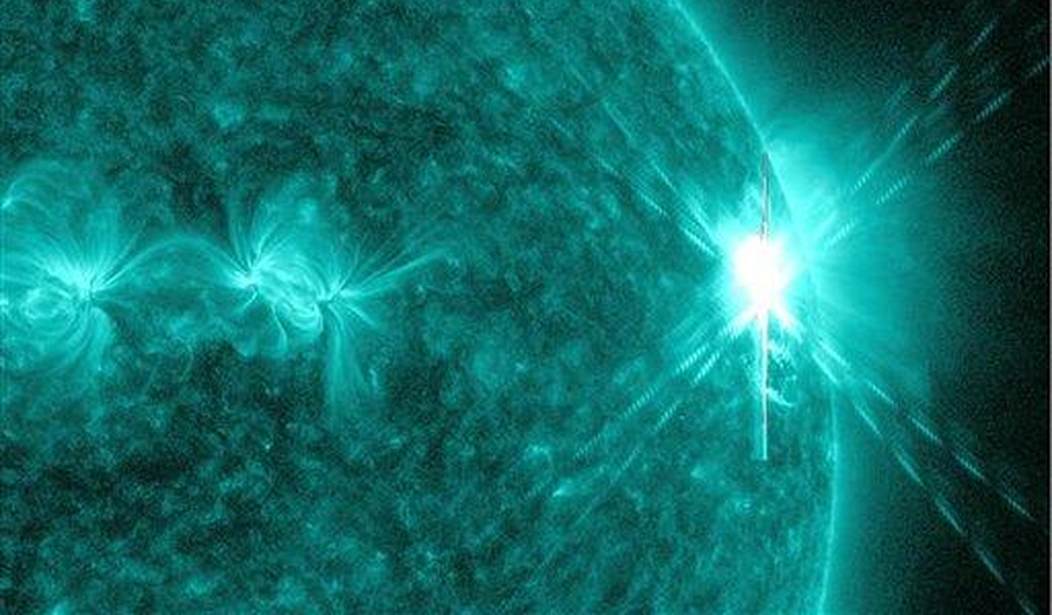As if you didn’t already have enough to worry about, what with the world apparently going crazy these days. Now we’ve learned that the sun has developed a massive sunspot that has produced what’s called a delta-class magnetic field. This is among the larger sunspots astronomers see and it’s currently pointed directly at the Earth. That is potentially a huge problem for us because this type of formation is capable of producing an X-class solar flare, the largest (and thankfully most rare) type of solar flare that our host star produces. And a sufficiently large X-class flare could wipe out a lot of the planet’s electrical infrastructure along with our satellites. Thankfully, the scientists studying this event estimate that there is only a 5% chance that a flare of that size will be produced. (Newsweek)
A giant sunspot may be about to erupt, sending out the most powerful form of solar flares growing for days.
Sunspot AR3089, which is facing towards the Earth, has now developed a delta-class magnetic field, meaning that it has built up enough energy that it may release X-class solar flares.
According to National Oceanic and Atmospheric Administration (NOAA), there is around a five percent chance that the sunspot will release an X-class flare. If it does, the flare may trigger a powerful geomagnetic storm in the Earth’s atmosphere, possibly resulting in damage to infrastructure and electromagnetic communication systems.
There are five general classes of solar flares identified as A, B, C, M, and X. The A, B, and C-class flares are small and don’t produce many noticeable effects on earth even if they hit us directly. The M-class flares are of medium size and can cause temporary satellite disruptions, along with magnificent displays of the Northern and Southern Lights stretching far closer to the equator than they are normally seen.
But the X-class flares are the real monsters. The smallest of them, the X1 class, is at least ten times larger than the average M-class flare. They climb up in size from there. An X10 class flare is ten times larger than the X1 as the name implies. It would produce an electromagnetic pulse in our atmosphere that could potentially produce catastrophic damage to everything with electrical circuits in it.
The last time a large X-class flare is believed to have directly hit the earth was in 1859 in what came to be known as the Carrington event. While most of the world didn’t notice it, the pulse produced by the flare destroyed a significant amount of the nascent telegraph system in North America, with some telegraph stations catching fire.
We recovered from that quickly enough, but the same would likely not be true today. EMPs from these massive flares don’t actually produce any effects on plants and animals that you would be likely to notice. But the pulse of electricity that they produce in electrical conductors is huge, so they can destroy all manner of electrical devices and power lines, particularly the huge transformers with vast lengths of coils in them.
It’s tempting to think that we’ll be okay if the flare hits when our side of the planet is facing away from the sun. Unfortunately, the average length of this type of solar storm is one to two days. And if that’s the case, then the entire planet’s infrastructure will be at serious risk, depending on whether or not the sunspot actually produces and flare and how big it is.
So what can we do about it? Well… nothing really. You would need to shield all of our technology in dense, expensive (and heavy) insulation using water and lead. It’s just not plausible, so we’ve gone along for a long time just accepting the risk. But even if this sunspot doesn’t throw an X10 or higher at us, history informs us that it’s going to happen sooner or later. Look on the bright side, though. The aurora borealis should put on one heck of a show for you while the lights are going out.








Join the conversation as a VIP Member